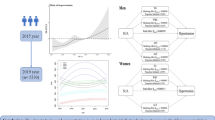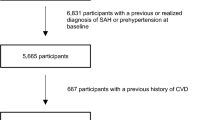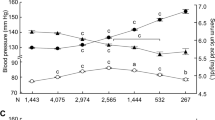Abstract
Many studies have demonstrated that elevated serum uric acid independently increases the risk of developing hypertension. However, the role of insulin resistance in the relationship between serum uric acid and hypertension is still unelucidated. Based on a prospective cohort study, we aimed to examine the longitudinal link between serum uric acid and hypertension and whether this relationship was mediated by insulin resistance. Overall, 21,999 participants without hypertension or gout at baseline with a mean age of 46 ± 13 years in the Jinchang Cohort were included in our study. Adjusted Cox-regression analyses and mediation analyses were performed to assess the risk of hypertension by serum uric acid quartile distribution and whether insulin resistance mediated the association between serum uric acid and hypertension. During the first follow-up period, 3080 participants developed hypertension. After controlling for covariates, compared with the lowest quartile of serum uric acid, the risk of hypertension in the highest quartile was 1.21 (1.06, 1.38) in the overall population. The risks for males and females were 1.14 (1.00–1.29) and 1.30 (1.08–1.56), respectively. The correlation between serum uric acid and hypertension was especially observed in younger people (<30 years). The mediating effects of insulin resistance were 0.058 (0.051, 0.065), 0.030 (0.025, 0.036) and 0.056 (0.047, 0.065), and the proportions mediated were 39.73, 36.59 and 38.62% in the overall, male and female populations, respectively. Elevated serum uric acid levels are associated with an increased risk of incident hypertension, and insulin resistance may play a mediating role in the relationship between serum uric acid and hypertension.
This is a preview of subscription content, access via your institution
Access options
Subscribe to this journal
Receive 12 digital issues and online access to articles
$119.00 per year
only $9.92 per issue
Buy this article
- Purchase on Springer Link
- Instant access to full article PDF
Prices may be subject to local taxes which are calculated during checkout




Similar content being viewed by others
References
Yu TY, Jee JH, Bae JC, Jin SM, Baek JH, Lee MK, et al. Serum uric acid: a strong and independent predictor of metabolic syndrome after adjusting for body composition. Metab-Clin Exp. 2016;65:432–40.
Mortada I. Hyperuricemia, type 2 diabetes mellitus, and hypertension: an emerging association. Curr Hypertens Rep. 2017;19:69.
Borghi C, Rosei EA, Bardin T, Dawson J, Dominiczak A, Kielstein JT, et al. Serum uric acid and the risk of cardiovascular and renal disease. J Hypertens. 2015;33:1729–41.
Kanbay M, Segal M, Afsar B, Kang DH, Rodriguez-Iturbe B, Johnson RJ. The role of uric acid in the pathogenesis of human cardiovascular disease. Heart. 2013;99:759–66.
Sung KC, Byrne CD, Ryu S, Lee JY, Lee SH, Kim JY, et al. Baseline and change in uric acid concentration over time are associated with incident hypertension in large Korean cohort. Am J Hypertens. 2017;30:42–50.
Feig DI, Johnson RJ. Hyperuricemia in childhood primary hypertension. Hypertension. 2003;42:247–52.
Cui L-F, Shi H-J, Wu S-L, Shu R, Liu N, Wang G-Y, et al. Association of serum uric acid and risk of hypertension in adults: a prospective study of Kailuan Corporation cohort. Clin Rheumatol. 2017;36:1103–10.
Grayson PC, Kim SY, LaValley M, Choi HK. Hyperuricemia and incident hypertension: a systematic review and meta-analysis. Arthritis Care Res. 2011;63:102–10.
Zhu Y, Hu Y, Huang T, Zhang Y, Li Z, Luo C, et al. High uric acid directly inhibits insulin signalling and induces insulin resistance. Biochem Biophys Res Commun. 2014;447:707–14.
Lamounier-Zepter V, Ehrhart-Bornstein M, Bornstein SR. Insulin resistance in hypertension and cardiovascular disease. Best Pr Res Clin Endoc Metab. 2006;20:355–67.
Cassano V, Crescibene D, Hribal ML, Pelaia C, Armentaro G, Magurno M, et al. Uric acid and vascular damage in essential hypertension: role of insulin resistance. Nutrients. 2020;12:2509.
Sun ZJ. Aging, arterial stiffness, and hypertension. Hypertension. 2015;65:252–6.
Hanan T, Lan L, Qu R, Xu Q, Jiang R, Na L, et al. Temporal relationship between hyperuricemia and insulin resistance and its impact on future risk of hypertension. Hypertension. 2017;70:703–11.
Bai Y, Yang A, Pu H, Dai M, Cheng N, Ding J, et al. Cohort profile: the China Metal-Exposed Workers Cohort Study (Jinchang Cohort). Int J Epidemiol. 2017;46:1095–6e.
Chobanian AV, Bakris GL, Black HR, Cushman WC, Green LA, Izzo JL JR, et al. The Seventh Report of the Joint National Committee on Prevention, Detection, Evaluation, and Treatment of High Blood Pressure—the JNC 7 Report. JAMA. 2003;289:2560–72.
Alberti K, Zimmet PZ. Definition, diagnosis and classification of diabetes mellitus and its complications part 1: diagnosis and classification of diabetes mellitus—provisional report of a WHO consultation. Diabet Med. 1998;15:539–53.
Zhu J-R, Gao R-L, Zhao S-P, Lu G-P, Zhao D, Li J-J. 2016 Chinese guidelines for the management of dyslipidemia in adults joint committee for guideline revision. J Geriatr Cardiol. 2018;15:1–29.
Simental-Mendia LE, Rodriguez-Moran M, Guerrero-Romero F. The product of fasting glucose and triglycerides as surrogate for identifying insulin resistance in apparently healthy subjects. Metab Syndr Relat Disord. 2008;6:299–304.
Preacher KJ, Rucker DD, Hayes AF. Addressing moderated mediation hypotheses: theory, methods, and prescriptions. Multivar Behav Res. 2007;42:185–227.
Wei F, Sun N, Cai C, Feng S, Tian J, Shi W, et al. Associations between serum uric acid and the incidence of hypertension: a Chinese senior dynamic cohort study. J Transl Med. 2016;14:110.
Nishio S, Maruyama Y, Sugano N, Hosoya T, Yokoo T, Kuriyama S. Gender interaction of uric acid in the development of hypertension. Clin Exp Hypertens. 2018;40:446–51.
Qu LH, Jiang H, Chen JH. Effect of uric acid-lowering therapy on blood pressure: systematic review and meta-analysis. Ann Med. 2017;49:142–56.
Tuttle KR, Short RA, Johnson RJ. Sex differences in uric acid and risk factors for coronary artery disease. Am J Cardiol. 2001;87:1411–4.
Yang T, Chu C-H, Bai C-H, You S-L, Chou Y-C, Hwang L-C, et al. Uric acid concentration as a risk marker for blood pressure progression and incident hypertension: a Chinese cohort study. Metab-Clin Exp. 2012;61:1747–55.
Kuwabara M, Niwa K, Nishi Y, Mizuno A, Asano T, Masuda K, et al. Relationship between serum uric acid levels and hypertension among Japanese individuals not treated for hyperuricemia and hypertension. Hypertens Res. 2014;37:785–9.
Viazzi F, Rebora P, Giussani M, Orlando A, Stella A, Antolini L, et al. Increased serum uric acid levels blunt the antihypertensive efficacy of lifestyle modifications in children at cardiovascular risk. Hypertension. 2016;67:934–40.
Loeffler LF, Navas-Acien A, Brady TM, Miller ER III, Fadrowski JJ. Uric acid level and elevated blood pressure in US Adolescents National Health and Nutrition Examination Survey, 1999-2006. Hypertension. 2012;59:811–U145.
Kanbay M, Segal M, Afsar B, Kang D-H, Rodriguez-Iturbe B, Johnson RJ. The role of uric acid in the pathogenesis of human cardiovascular disease. Heart. 2013;99:759–66.
Yokoi Y, Kondo T, Okumura N, Shimokata K, Osugi S, Maeda K, et al. Serum uric acid as a predictor of future hypertension: stratified analysis based on body mass index and age. Prev Med. 2016;90:201–6.
Yoo TW, Sung KC, Shin HS, Kim BJ, Kim BS, Kang JH, et al. Relationship between serum uric acid concentration and insulin resistance and metabolic syndrome. Circ J. 2005;69:928–33.
Genovesi S, Brambilla P, Giussani M, Galbiati S, Mastriani S, Pieruzzi F, et al. Insulin resistance, prehypertension, hypertension and blood pressure values in paediatric age. J Hypertens. 2012;30:327–35.
Zheng RJ, Mao YS. Triglyceride and glucose (TyG) index as a predictor of incident hypertension: a 9-year longitudinal population-based study. Lipids Health Dis. 2017;16:175.
Cassano V, Crescibene D, Hribal ML, Pelaia C, Armentaro G, Magurno M, et al. Uric acid and vascular damage in essential hypertension: role of insulin resistance. Nutrients. 2020;12:2509.
Choi YJ, Yoon Y, Lee KY, Hien TT, Kang KW, Kim KC, et al. Uric acid induces endothelial dysfunction by vascular insulin resistance associated with the impairment of nitric oxide synthesis. FASEB J. 2014;28:3197–204.
Montezano AC, Dulak-Lis M, Tsiropoulou S, Harvey A, Briones AM, Touyz RM. Oxidative stress and human hypertension: vascular mechanisms, biomarkers, and novel therapies. Can J Cardiol. 2015;31:631–41.
Acknowledgements
The authors thank the graduate students of the Lanzhou University School of Public Health and the doctors of the Jinchuan Company Staff Hospital who have made significant contribution to the establishment of the Jinchang Cohort.
Funding
This work was supported by Belt and Road Special Project of Lanzhou University (2018ldbrzd008) and Natural Science Foundation of China (No. 81673248).
Author information
Authors and Affiliations
Corresponding author
Ethics declarations
Competing interests
The authors declare no competing interests.
Additional information
Publisher’s note Springer Nature remains neutral with regard to jurisdictional claims in published maps and institutional affiliations.
Supplementary information
Rights and permissions
About this article
Cite this article
Wang, R., Bai, Z., Zhang, D. et al. Mediating effects of insulin resistance on the development of hypertension associated with elevated serum uric acid: a prospective cohort study. J Hum Hypertens 36, 760–766 (2022). https://doi.org/10.1038/s41371-021-00562-z
Received:
Revised:
Accepted:
Published:
Issue Date:
DOI: https://doi.org/10.1038/s41371-021-00562-z



